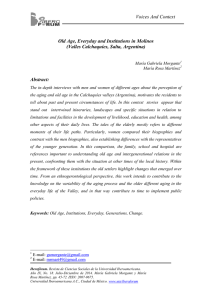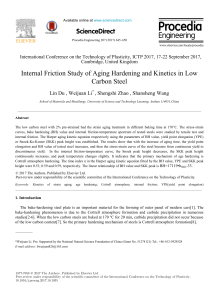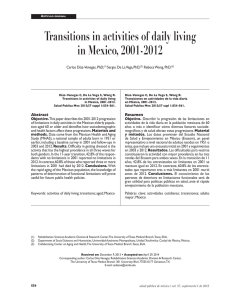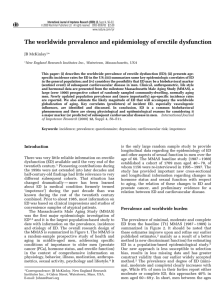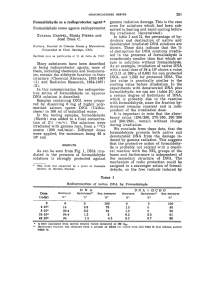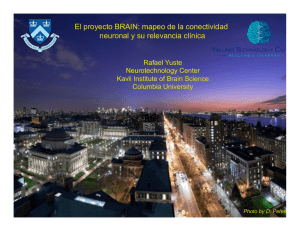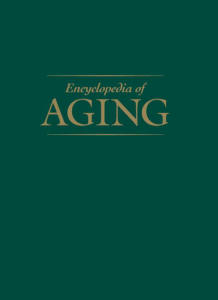Review of biological hypotheses explaining aging
Anuncio
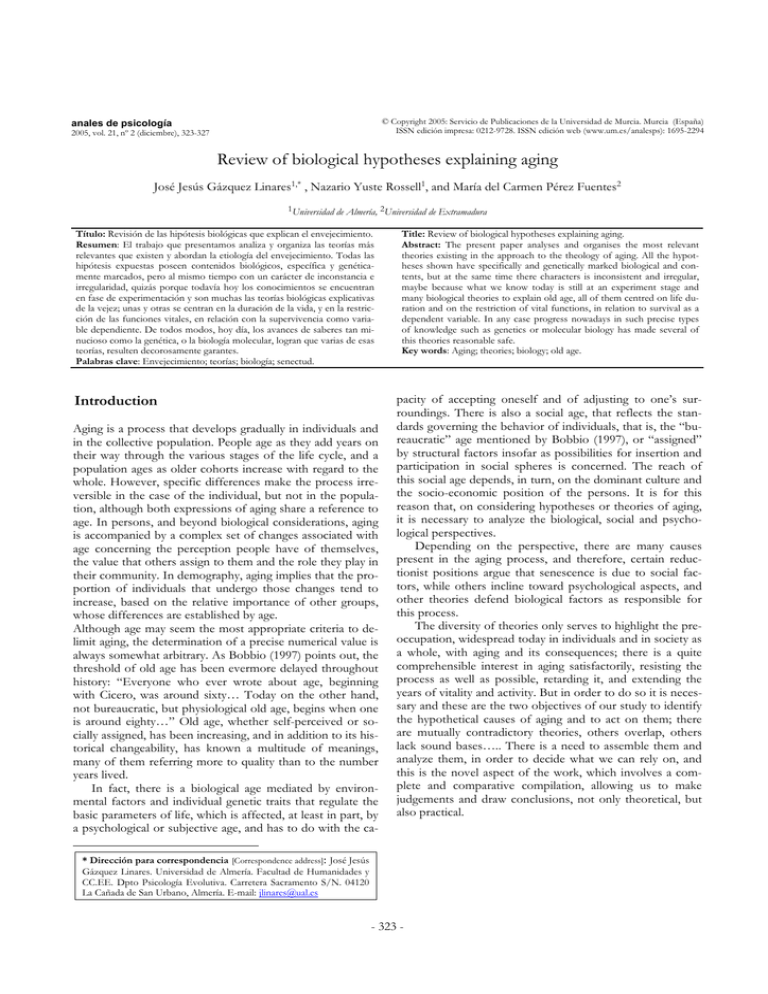
© Copyright 2005: Servicio de Publicaciones de la Universidad de Murcia. Murcia (España) ISSN edición impresa: 0212-9728. ISSN edición web (www.um.es/analesps): 1695-2294 anales de psicología 2005, vol. 21, nº 2 (diciembre), 323-327 Review of biological hypotheses explaining aging José Jesús Gázquez Linares1,* , Nazario Yuste Rossell1, and María del Carmen Pérez Fuentes2 1Universidad de Almería, 2Universidad de Extramadura Título: Revisión de las hipótesis biológicas que explican el envejecimiento. Resumen: El trabajo que presentamos analiza y organiza las teorías más relevantes que existen y abordan la etiología del envejecimiento. Todas las hipótesis expuestas poseen contenidos biológicos, específica y genéticamente marcados, pero al mismo tiempo con un carácter de inconstancia e irregularidad, quizás porque todavía hoy los conocimientos se encuentran en fase de experimentación y son muchas las teorías biológicas explicativas de la vejez; unas y otras se centran en la duración de la vida, y en la restricción de las funciones vitales, en relación con la supervivencia como variable dependiente. De todos modos, hoy día, los avances de saberes tan minucioso como la genética, o la biología molecular, logran que varias de esas teorías, resulten decorosamente garantes. Palabras clave: Envejecimiento; teorías; biología; senectud. Introduction Aging is a process that develops gradually in individuals and in the collective population. People age as they add years on their way through the various stages of the life cycle, and a population ages as older cohorts increase with regard to the whole. However, specific differences make the process irreversible in the case of the individual, but not in the population, although both expressions of aging share a reference to age. In persons, and beyond biological considerations, aging is accompanied by a complex set of changes associated with age concerning the perception people have of themselves, the value that others assign to them and the role they play in their community. In demography, aging implies that the proportion of individuals that undergo those changes tend to increase, based on the relative importance of other groups, whose differences are established by age. Although age may seem the most appropriate criteria to delimit aging, the determination of a precise numerical value is always somewhat arbitrary. As Bobbio (1997) points out, the threshold of old age has been evermore delayed throughout history: “Everyone who ever wrote about age, beginning with Cicero, was around sixty… Today on the other hand, not bureaucratic, but physiological old age, begins when one is around eighty…” Old age, whether self-perceived or socially assigned, has been increasing, and in addition to its historical changeability, has known a multitude of meanings, many of them referring more to quality than to the number years lived. In fact, there is a biological age mediated by environmental factors and individual genetic traits that regulate the basic parameters of life, which is affected, at least in part, by a psychological or subjective age, and has to do with the ca- Title: Review of biological hypotheses explaining aging. Abstract: The present paper analyses and organises the most relevant theories existing in the approach to the theology of aging. All the hypotheses shown have specifically and genetically marked biological and contents, but at the same time there characters is inconsistent and irregular, maybe because what we know today is still at an experiment stage and many biological theories to explain old age, all of them centred on life duration and on the restriction of vital functions, in relation to survival as a dependent variable. In any case progress nowadays in such precise types of knowledge such as genetics or molecular biology has made several of this theories reasonable safe. Key words: Aging; theories; biology; old age. pacity of accepting oneself and of adjusting to one’s surroundings. There is also a social age, that reflects the standards governing the behavior of individuals, that is, the “bureaucratic” age mentioned by Bobbio (1997), or “assigned” by structural factors insofar as possibilities for insertion and participation in social spheres is concerned. The reach of this social age depends, in turn, on the dominant culture and the socio-economic position of the persons. It is for this reason that, on considering hypotheses or theories of aging, it is necessary to analyze the biological, social and psychological perspectives. Depending on the perspective, there are many causes present in the aging process, and therefore, certain reductionist positions argue that senescence is due to social factors, while others incline toward psychological aspects, and other theories defend biological factors as responsible for this process. The diversity of theories only serves to highlight the preoccupation, widespread today in individuals and in society as a whole, with aging and its consequences; there is a quite comprehensible interest in aging satisfactorily, resisting the process as well as possible, retarding it, and extending the years of vitality and activity. But in order to do so it is necessary and these are the two objectives of our study to identify the hypothetical causes of aging and to act on them; there are mutually contradictory theories, others overlap, others lack sound bases….. There is a need to assemble them and analyze them, in order to decide what we can rely on, and this is the novel aspect of the work, which involves a complete and comparative compilation, allowing us to make judgements and draw conclusions, not only theoretical, but also practical. * Dirección para correspondencia [Correspondence address]: José Jesús Gázquez Linares. Universidad de Almería. Facultad de Humanidades y CC.EE. Dpto Psicología Evolutiva. Carretera Sacramento S/N. 04120 La Cañada de San Urbano, Almería. E-mail: [email protected] - 323 - 324 José Jesús Gázquez Linares, Nazario Yuste Rossell y María del Carmen Pérez Fuentes Biological theories of aging All these theories start out from a background in which experts conclude that aging is due to organic and biotic causes; therefore, and depending on the factors that are judged to be determining, or responsible for old age, these theories can be classified according to Shock (1997), as: - Those that place the emphasis on genetic or hereditary causes, also called primary aging theories, where inheritance is what decides aging, by a scaled process that extends through the entire life cycle. - Those that attribute aging to pathological, degenerative causes and natural wear, due to the passage of time, also called secondary aging theories. It is argued that the continued use and, even more so, abuse, but also disuse, over the years, lead to deterioration, to illness, to diminishing the efficiency of organs and faculties. - And finally, the so-called tertiary aging theories, or those that postulate that aging is due to the degeneration of some or of all of the physiological systems or mechanisms, such as cardiovascular, or central nervous system. We shall begin by briefly analyzing the different biological theories that comprise each of the three types of aging. Biological theories of primary aging All of these particularly emphasize the human genome, postulating that all human beings are predestined to a succession of events that culminate in old age; every animal and plant species receives programming from its ancestors that necessarily leads to age and consequently to a certain lifespan; that is why, in common language, they say that living longer depends on the longevity of the parents, as indicated by Robbins (1990); but we should not forget the affirmation of Mishara and Riedel (1986), that for human beings “it is difficult, if not impossible, to distinguish between genetic factors and life styles or even factors such as diet or surroundings. In fact, parents and children not only have similar genes, but also show a tendency to eat in the same way, live in comparable atmospheres and adopt the same sanitary habits.” As Schock (1977) explains concerning the genetic perspective, “the organism is informed by DNA molecules of its existential programming. This information goes through several stages, and causes the formation of certain proteins for the continued functioning of the cells of each animal. The cell’s destiny is death, but the cause that triggers it – whether a short circuit in the genes of youth, or those of senescence connect – is unknown.” We go on to describe the various biological theories of primary aging. Programmed aging or general genetic theory.- Defends the existence of a genetic plan for the lifespan of the subject in DNA; that is, old age appears and develops according to anales de psicología, 2005, vol. 21, nº 2 (diciembre) the hereditary information and content of the genes, DNA being its conclusive element. (Yuste and Yuste, 2000). Cell multiplication limit theory.- Put forward primarily by Leonard Hayflick (1974, 1999), who argued that “studies on old age are not so much about achieving greater longevity as lengthening the years of greatest energy and activity of the human being.” Hayflick (1974) who when studying the cell cycle and behavior of animal cells, discovered that the number of divisions of normal cells is not unlimited in its regeneration, but restricted, which means that no matter how much medicine progresses in saving life, unlimited life expectations can never be achieved by it (Yuste and Yuste, 2000). Theories of endogenous aging of cells.- It has been verified that with age, cell functions gradually diminish. These, upon aging, are less prone to nutrition, to stanch wounds, and to eliminate waste, which accumulates continuously and severely. The final reason for these failures in cell behavior is unknown, and has given rise to diverse hypotheses, all of which focus on DNA failures. There are three main theories on endogenous aging of cells. Free-radical, or peroxidation theory.- Defended by Harman (1956), is today completely current. Free radicals are very reactive molecules derived above all from the monovalent reduction of oxygen; it is blamed for the excess of superoxidized free radicals, for severe anomalies in the immune function and for deficient emission to the cell nucleus of adequate stimuli. This theory, then, bases cell aging and senescence, on intra-cytoplasmic and interstitial formation of free radicals (Crastes de Palueta, 1990) from both endogenous and exogenous sources, which throughout life cause an unknown amount of damage to DNA and RNA, proteins and enzymes. Theory of errors.- Introduced by Orgel (1973), defends the idea that genetic confusion and mistakes occur that provide the body’s cells with incorrect information, and even total loss of vital messages. Therefore, according to this theory of cellular aging, death of the cells, and consequently senescence, are corollaries of the errors that arise in some link in the chain between DNA and the final protein required. It is advisable to point out that this theory is a very imprecise proposal, first because the steps in the process are very numerous and failures, therefore, can arise in any of them; and in the second place, because with aging, cell function does not diminish randomly and occasionally, but deliberately, although gradually and constantly (Yuste and Yuste, 2000). Theory of the critical threshold of accumulated errors.This theory is very similar to Orgel’s. It proposes that cellular death occurs when defense systems are no longer able, for one reason or another, to resist the continuous alterations in cell components. It also sustains that death of the 325 Review of biological hypotheses explaining aging cell occurs when it exceeds a certain level, or threshold of supportable errors. The theory does not explain how, or why, during the process of cellular aging, the level of failures increases, but may nonetheless serve as a basis for clarifying the appearance of certain pathologies connected with senescence (Toussaint, 1993). Theory of somatic mutation of restoration of failures.With this theory, Hart and Setlow (1976) discredit the theory of Orge, postulating the spontaneous restoration of injuries to the DNA. Ravin, improving on the theory of Orge, had already suggested that the aging process was due, not to the progressive accumulation of failures in the cell genome, but to the growing inability to correct them. This has been confirmed by several studies which make it clear that the potential for repair of nuclear DNA is positively related to life expectancy of the species, and negatively to progression toward the end of the cell cycle. Summarizing, what this theory postulates is that what determines the decrease in the ability of the cell to survive, and therefore its death, is the failure to immediately restore the errors in DNA replication, although this has not yet been proven in the laboratory (Tice y Setlow, 1985). Theory of highly redundant irreparable rupture of DNA.- Three types of DNA sequences have been described in the cellular genome: single DNA sequences, which include the majority of the vital proteins, moderately repetitive sequences (between 10 and 10.4 copies), and highly repetitive or redundant sequences (10.5 copies or more), which come to approximately 25% of the cellular genome, and the function of which is still not very well known. It seems that these last DNA sequences code drivers of the meaning of the information that RNA transmits, and it also seems, that the physiological breakdown of that DNA is the means by which an ever-greater cellular differentiation is produced, which is paired to a progressive reduction in functions. All of which could accredit the growing functional failures peculiar to cellular aging. Accumulated waste theory.- This could occur as a consequence of the accumulation of waste when the original cellular capacity to eliminate it falls apart, with which the oxidation rate decreases, arriving at loss of functions, and of the natural activity of the cell. There is a positive correlation between aging of the subject and progress of cell decadence due to piling up of subproducts and cellular detritus. Although at the present time, it is unknown whether those toxic products are the direct cause of aging, or only the unavoidable result of other concomitant and as yet unknown physical alterations. Secondary biological theories of aging These theories, as mentioned above, argue that pathological and degenerative causes are responsible for changes in the cells, whether due to very poor oxygenation, or infiltration of chemicals, or to poor nutrition, that reduce their competence and provoke cellular death, that is, aging. We can highlight four major theories in this section: Wear and tear theory.- This theory, also called the stochastic theory, explains aging of the cells as a consequence of continued exposure throughout life, to noxious factors, from both endogenous and exogenous sources, but that cause progressive detriment to the capacity for survival. Similar to the mechanist model, it starts out from the assumption that the organism can be compared to the pieces of a machine that with the passage of time, use and abuse wear out, which would give rise to something similar to rusting and molding; but would not be a valid principle, since the organism is regenerated, or what is the same, has a selfrepair system (Yuste and Yuste, 2000). Theory of accumulation of deleterious molecules in blood.- Noxious molecules are accumulated in plasma, which impedes cell development. This accumulation of pigments impedes the diffusing potential of the cell membranes; although it still needs to be developed and demonstrated empirically. Deprivation theory.- Sustains that what causes the aging process is the lack of correct nutrition which cells are subjected to because of age. This is why arteriosclerosis appears, which thus becomes the final cause of cells and tissues being undernourished and thereby, weakens their functions. Crossed-linking Theory.- Based on extracellular and intracellular posttranslational molecular modifications that are generated with age, Bjorksten (1968) was the first to speak of certain connections, macromolecules which over the years are formed by binding the component parts of different molecules together forming loops between them. These form rigid, lasting joints which keep them from working properly or being restored. Cerami (1990), sustains as a universal phenomenon that, over the years, non-enzymatic glucose is bound to protein forming crossed links with adjacent proteins. It has been shown that, over time, the number of crossed links increases, leading to an inverse decrease in permeability and elasticity in the extracellular environment; in the end, on one hand, a disturbance in the current of nutrients toward the interior of the cell, and on the other, a perturbation in the evacuation of waste toward the outside. One of the basic proteins affected is collage, which over the years becomes heavy, thick and pasty. Tertiary biological theories of aging Emphasize the degeneration of some of the control systems or mechanisms, such as the immune, neuroendocrine, cardiovascular or nervous system, so there are diverse theories depending on the system described. anales de psicología, 2005, vol. 21, nº 2 (diciembre) 326 José Jesús Gázquez Linares, Nazario Yuste Rossell y María del Carmen Pérez Fuentes Decreased immunological function theory.- According to Robbins (1990), three basic facts support it: In the first place, quantitative and qualitative production of antibodies is gradually incapacitated, so the elderly are more susceptible to infection, later, as age advances, there is a propensity to more development of autoimmune diseases and finally, an acute decrease in the function of T-lymphocytes, with respect to age. Endocrine system transformation theory.- It is well known that the structure of this system is made up of various glands such as the thyroid, suprarenal and gonads, which are controlled and governed by the anterior pituitary. Backed by several different authors, among them Finch and Hayflick (1977), the theory of changes in the endocrine system sustains that the main cause of old age, among the various causes that contribute to it, is due to chemical alteration in the organism. Thyroid gland deterioration theory.- The authors who defend this theory believe that the alteration of this gland is what determines aging and argue that many subjects who are patients of hyperthyroidism have the same symptoms as the elderly, such as slowing down or getting bald. Theory of deterioration of sex glands.- In addition to spermatogenesis, the secretion of various hormones, such as testosterone, the ovaries or female gonads, as an endocrine gland also controlled by the hypothalamus-pituitary axis, secret gestagen and estrogen, in addition to a small amount of androgens, making the defenders of this theory postulate that a physiological decrement in these glands causes aging. Pituitary dysfunction theory.- According to Dilman (1971), this is the cause of the aging process, based on the decisive importance of this gland in the entire endocrine adjustment, since it governs the functioning of other internal secretion glands. Cardiovascular aging theory.- It would seem obvious that the majority of deaths, in the end, are due to a problem in the heart. The authors who defend this theory blame the cardiovascular system as being directly responsible not only for death, especially in elderly persons, but also for the aging process itself, due to gradual decadence and degradation of the blood vessels, which is translated into arteriosclerosis and diminishing the blood supply. Theory of disorganization of the nervous system.- There can be no doubt of the relevance of the nervous system, since it is well known that it intervenes in physiological activity, apart from being in charge of pituitary activity, so this theory defends that the incapacities present in old age may anales de psicología, 2005, vol. 21, nº 2 (diciembre) be the reflection of a decline in the integrative functions of the neuroendocrine system. Multifactorial theory of aging.- This theory, which emerges from an attempt to unify positions, may be summarized according to Olson (1987) as: - Blaming an excess of superoxidized free radicals due to endogenous enzymatic reactions and environmental attack for severe anomalies in immune functions and deficient emission of the proper stimuli to the cell nucleus. - Cytoplasmic communication having been interfered with, the cell nucleus gradually becomes reluctant to generate responses. - During cellular differentiation, there is a progressive physiological scission of highly redundant DNA, a constant increase in mutations in it, and growing inefficiency in genome self-restoration. All of this triggers continuous cellular aging, or alternatively, perhaps, aberrations in the rest of the DNA (Yuste and Yuste, 2000). Conclusions It is noticeable that all of these theories focus on some biological aspect, but none of them makes any convincing arguments for the etiology of aging, so that it can be attributed to any of them; even so, the current and most viable view is that its etiopathogenesis is the combination, synchronic or sequential, of several endogenous and exogenous causes. Indeed. We know that development is genetically set, but there is doubt over which factor of the organism controls aging. It does not appear to be the cardiovascular system, which shows no excessive dysfunction due to age; nor is it clear to what extent the thymus and T lymphocytes are involved. Undoubtedly, there is more than one factor at work. At the same time, and on the one hand, it seems that error theory and error accumulation theory are inaccurate, as is that of the accumulation of waste products, that of deleterious molecules in the blood (which in the end are errors), and that of cross-linkage, which affects, among other proteins, collagen, of less importance than the publicity would have us believe; but on the other hand, these theories of errors ignore the restorative capacity of the organism (as do the wear-and-tear theory, that of deprivation due to age, and that of error repair), while there is ample evidence of the important effects of other faults, such as that of the rupture of highly redundant DNA, or that of free radicals, whose endogenous and exogenous origin means that, in this regard, the conscious contribution of the individual is indeed a decisive factor. Taking all of the above into account, then, it can be argued that aging is part and parcel of our life. Even so, that should not lead us to neglect beneficial behaviours; on the contrary, in view of the clearly complex etiology, we should develop preventive behaviours, such as hypocalorific diets and the use of antioxidants. Review of biological hypotheses explaining aging 327 Referencias Bobbio, N. (1997). De senectute. Barcelona: Taurus. Brownlee, M., y Cerami A. (1990). The biochemistry of the complications of diabetes mellitus. Ann Rev Biochem, 50, 385-432. Crastes De Pauleta, A. (1990). Radicaux libres e vieillissement. Ann Biolog Clin, 48, 323-330. Dilman, V.M. (1970). The Law of Deviation of Homeostasis and Diseases of Aging. Littleton: John Wright. Finch, C.E. y Hayflick, L. (1977). Handbook of biology of aging. New York: Van Reinhold Co. Harman, D. (1956). Aging: a theory based on free radical and radiation chemistry. Journal Gerontol, 11, 298-300. Hart, R.W., y Setlow, R.B. (1976). DNA repair in late-passage human cells. Mech Ageing Dev, 5(1), 67-77. Hayflick, L. (1974). The strategy of senescence. The Gerontologist, 14, 37-45. Hayflick, L. (1999). Cómo y por qué envejecemos. Barcelona: Herder. Mishara, B.L. y Riedel, R.G. (1984). El proceso de envejecimiento. Madrid: Morata. Olson, C.B. (1987). A review of why and how we age: A defense of multifactorial aging. Ageing Dev, 41. Orgel, L.E. (1973). Ageing of clones of mammalian cells. Nature, 243, 441445. Robbins, C.K. (1990). Patología estructural y funcional. Madrid: McGraw-Hill. Ssock, N.W. (1977). Biological theories of aging. En J.E. Birren, y K.W. Schaie (Eds.), Handbook of the Psychology of Agins. New York: Van Nostrand Reinhold. Tice, R.R. y Sstlow, R.B. (1985). DNA repair and replication in aging organisms and cells. En C.E. Finch, y E.I. Schneider (Eds.), Handbook of the biology of aging (2ª ed.), New York: Van Nostrand Reinhold. Toussaint, O. (1993). La biología del envejecimiento celular II. El umbral crítico de acumulación de errores: sus cualidades, limitaciones y consecuencias en las enfermedades crónicas asociadas al envejecimiento. Revista de Gerontología, 3(4), 217-227. Yuste, N. (2000). En pos de la comprensión de la adultez y senectud. Almería: SPU (Artículo recibido: 17-12-04, aceptado: 19-9-05) anales de psicología, 2005, vol. 21, nº 2 (diciembre)
